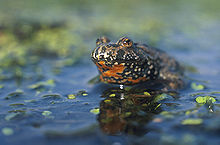Fire-bellied toad: Difference between revisions
m →External links: HTTP → HTTPS for Inter-Research Science Publisher, replaced: http://www.int-res.com/ → https://www.int-res.com/ |
Fire water toads Tags: Reverted Mobile edit Mobile web edit |
||
| Line 1: | Line 1: | ||
{{more footnotes|date=November 2015}} |
{{more footnotes|date=November 2015}} |
||
{{Automatic taxobox |
{{Automatic taxobox |
||
| name = Fire- |
| name = Fire-water toads |
||
| image = Bombina bombina 2 (Marek Szczepanek).jpg |
| image = Bombina bombina 2 (Marek Szczepanek).jpg |
||
| image_caption = [[European fire-bellied toad]] (''Bombina bombina'') |
| image_caption = [[European fire-bellied toad]] (''Bombina bombina'') |
||
Revision as of 09:18, 30 March 2020
This article includes a list of general references, but it lacks sufficient corresponding inline citations. (November 2015) |
| Fire-water toads | |
|---|---|

| |
| European fire-bellied toad (Bombina bombina) | |
| Scientific classification | |
| Domain: | Eukaryota |
| Kingdom: | Animalia |
| Phylum: | Chordata |
| Class: | Amphibia |
| Order: | Anura |
| Family: | Bombinatoridae |
| Genus: | Bombina Oken, 1816 |
| Species | |
|
See text | |
| Synonyms | |
|
List
| |
The fire-bellied toads are a group of six species of small frogs (most species typically no longer than 1.6 in or 4.1 cm) belonging to the genus Bombina.
The name "fire-bellied" is derived from the brightly colored red- or yellow-and-black patterns on the toads' ventral regions, which act as aposematic coloration, a warning to predators of the toads' reputedly foul taste. The other parts of the toads' skins are green or dark brown. When confronted with a potential predator, these toads commonly engage in an Unkenreflex, "Unken-" being the combining form of "Unke", German for fire-bellied toad. In the Unkenreflex, the toad arches its back, raising its front and back legs to display the aposematic coloration of its ventral side.
Species
The currently recognized species are:[1]
- Bombina bombina (Linnaeus, 1761) – European fire-bellied toad
- Bombina microdeladigitora Liu, Hu & Yang, 1960 – Hubei firebelly toad, and other names
- Bombina maxima (Boulenger, 1905) – Yunnan firebelly toad
- Bombina orientalis (Boulenger, 1890) – Oriental fire-bellied toad
- Bombina pachypus (Bonaparte, 1838) – Apennine yellow-bellied toad
- Bombina variegata (Linnaeus, 1758) – yellow-bellied toad
Biology
The female of the species typically lays 80–300 eggs that can be found hanging off plant stems. The offspring develop in pools or puddles. Their metamorphosis is complete within a few weeks, peaking in July–August. The toadlets attain a length of 12–15 mm. The eggs, laid in August, metamorphose only after the winter, with the toadlets attaining a length of 3–5 cm. These toadlets still have white bellies.
Tadpoles eat mainly algae and higher plants. The young toads and the adult toads consume insects, such as flies and beetles, shrimp and larvae; but also annelid worms and terrestrial [
Distribution and habitat
The species can be found both in Europe and in areas in Asia with a moderate climate.
All kinds of toads prefer habitats of stagnant water, which they are reluctant to leave. The fire-bellied toad lives primarily in a continental climate in standing water or calmer backwaters of rivers or ponds. The species can also be found in flood pools and in floodplains. The yellow-bellied species typically live at higher altitude, where they are primarily found in small bodies of water like ponds or water-filled ruts, often near small mountain streams. The Asian species also live in small bodies of water and can live at altitudes of over 3000 meters
Captivity
Several species in the genus Bombina, particularly B. orientalis, B bombina, and B. variegata, are commonly kept as exotic pets and are readily available in many pet stores.[2] In captivity, they are easily maintained in vivaria, and when provided with proper food and environmental conditions, often prove to be robust, flamboyant, and long-lived amphibians. Captive fire-bellied toads can live from 10–15 years.[3]
In captivity, they eat a wide variety of food, including crickets, moths, minnows, blood worms and pinkie mice, though some frogs cannot handle certain foods, due to their size. They can sometimes act very aggressively against each other, particularly males. They have a ferocious appetite. Due to this, its best to monitor their food intake to ensure they're not over eating.
Fire-bellied toads are easy to raise and handle in quantity. This makes them advantageous to study in various sciences.[4]
References
- ^ Bombina, Amphibian Species of the World 5.6
- ^ R. Ricciuti, Edward (1 August 2003). Killer Animals: Shocking True Stories of Deadly Conflicts Between Humans and Animals. Lyons Press; First edition. pp. 146, 308. ISBN 978-1585748686. Retrieved 5 November 2015.
- ^ "Oriental Fire-bellied Toad". City of Edmonton. Retrieved 5 November 2015.
- ^ Fong, Jonathan J.; Li, Pi-Peng; Yang, Bao-Tian; Zhou, Zheng-Yan; Leaché, Adam D.; Min, Mi-Sook; Waldman, Bruce (2016-04-01). "Influence of geology and human activity on the genetic structure and demography of the Oriental fire-bellied toad (Bombina orientalis)". Molecular Phylogenetics and Evolution. 97: 69–75. doi:10.1016/j.ympev.2015.12.019. PMID 26748269.
- Schilthuizen, Menno (2002). Frogs Flies and Dandelions: The Making of Species, Oxford University Press. 254 pages. ISBN 978-0-19-850392-7.
- Oriental Fire-Bellied Toad, National Geographic
